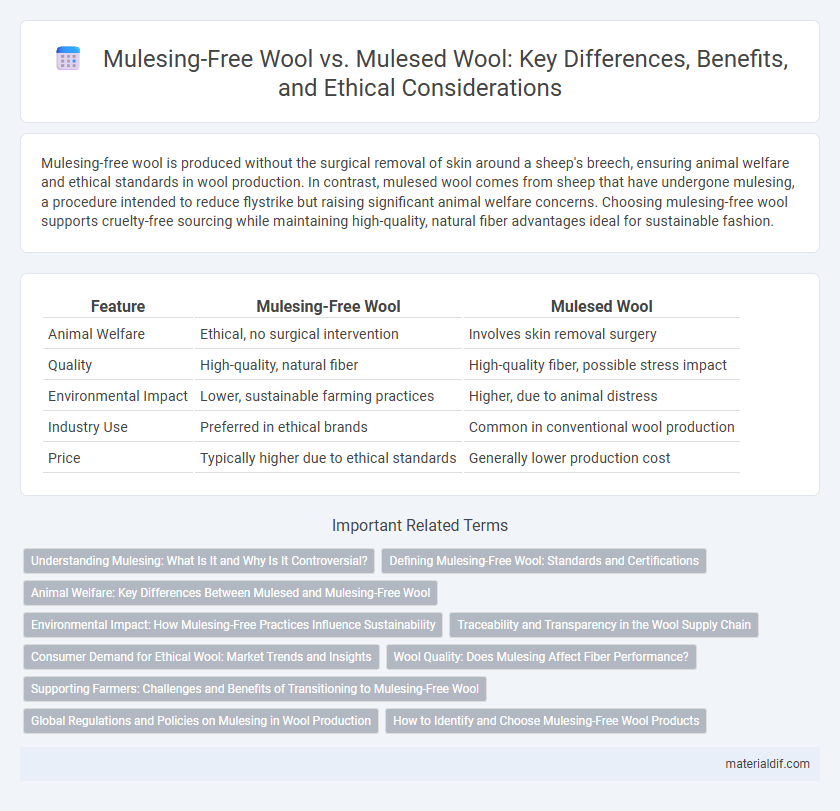Mulesing-free wool is produced without the surgical removal of skin around a sheep's breech, ensuring animal welfare and ethical standards in wool production. In contrast, mulesed wool comes from sheep that have undergone mulesing, a procedure intended to reduce flystrike but raising significant animal welfare concerns. Choosing mulesing-free wool supports cruelty-free sourcing while maintaining high-quality, natural fiber advantages ideal for sustainable fashion.
Table of Comparison
| Feature | Mulesing-Free Wool | Mulesed Wool |
|---|---|---|
| Animal Welfare | Ethical, no surgical intervention | Involves skin removal surgery |
| Quality | High-quality, natural fiber | High-quality fiber, possible stress impact |
| Environmental Impact | Lower, sustainable farming practices | Higher, due to animal distress |
| Industry Use | Preferred in ethical brands | Common in conventional wool production |
| Price | Typically higher due to ethical standards | Generally lower production cost |
Understanding Mulesing: What Is It and Why Is It Controversial?
Mulesing is a surgical procedure performed on sheep, primarily Merinos, to remove folds of skin around the breech area, aiming to prevent flystrike, a parasitic infection caused by blowflies. The controversy arises from animal welfare concerns, as the procedure is often done without anesthesia, causing pain and distress to the sheep, leading to growing demand for mulesing-free wool. Mulesing-free wool is sourced from sheep bred and managed using alternative flystrike prevention methods, aligning with ethical farming practices and increasing appeal to conscious consumers.
Defining Mulesing-Free Wool: Standards and Certifications
Mulesing-Free Wool is derived from sheep that have not undergone the controversial practice of mulesing, ensuring animal welfare and ethical sourcing. This wool adheres to strict standards set by certifications such as the Responsible Wool Standard (RWS) and ZQ Merino, which mandate non-mulesing practices alongside environmental and social responsibility. Brands and consumers prioritize these certifications to guarantee that the wool is produced without causing harm to sheep, promoting sustainable and cruelty-free textile production.
Animal Welfare: Key Differences Between Mulesed and Mulesing-Free Wool
Mulesing-free wool ensures sheep are not subjected to the painful skin removal practice used to prevent flystrike, significantly enhancing animal welfare by minimizing stress and injury. In contrast, mulesed wool involves the removal of skin around the sheep's breech area, a procedure often criticized for its ethical implications despite reducing parasitic risks. Choosing mulesing-free wool supports humane farming practices and aligns with growing consumer demand for ethically sourced textile products.
Environmental Impact: How Mulesing-Free Practices Influence Sustainability
Mulesing-free wool production significantly reduces environmental harm by eliminating the need for chemical treatments often used to prevent flystrike in mulesed sheep, thereby decreasing soil and water contamination. These practices promote animal welfare and support sustainable farming by encouraging natural pest control methods and improved pasture management, which enhances biodiversity and soil health. Transitioning to mulesing-free wool aligns with global sustainability goals by reducing greenhouse gas emissions and fostering regenerative agricultural systems.
Traceability and Transparency in the Wool Supply Chain
Mulesing-free wool offers enhanced traceability and transparency in the wool supply chain by allowing consumers and brands to verify animal welfare practices through certified and documented sources. This transparency supports ethical sourcing, providing assurances that no mulesing procedures were performed, and often incorporates blockchain or digital tracking systems for robust supply chain accountability. In contrast, wool from mulesed sheep frequently lacks the same level of traceability, making it challenging to confirm humane treatment and undermining consumer confidence in ethical claims.
Consumer Demand for Ethical Wool: Market Trends and Insights
Consumer demand for mulesing-free wool has surged as ethical considerations increasingly influence purchasing decisions in the textile industry. Market trends indicate a growing preference for cruelty-free, sustainable wool options, driven by heightened awareness of animal welfare and transparent supply chains. Retailers and brands are responding by sourcing mulesing-free wool to meet consumer expectations, reflecting a significant shift towards ethical and responsible fashion.
Wool Quality: Does Mulesing Affect Fiber Performance?
Mulesing-free wool maintains fiber integrity by avoiding skin tissue removal, resulting in softer, more uniform fibers with reduced risk of damage or contamination during growth. In contrast, mulesed wool may exhibit compromised fiber quality due to potential stress on the sheep's skin, which can affect fiber strength and length consistency. Research indicates mulesing does not inherently improve fiber performance, underscoring that mulesing-free wool can meet or exceed industry standards for softness, durability, and overall quality.
Supporting Farmers: Challenges and Benefits of Transitioning to Mulesing-Free Wool
Transitioning to mulesing-free wool presents challenges such as increased labor for flystrike prevention and the need for alternative pest management practices, which can initially raise production costs for farmers. However, adopting mulesing-free methods supports animal welfare standards, potentially accessing premium markets and consumer segments willing to pay higher prices for ethically produced wool. Long-term benefits include improved farm sustainability and enhanced brand reputation, encouraging industry-wide shifts toward mulesing-free wool production.
Global Regulations and Policies on Mulesing in Wool Production
Global regulations on mulesing vary widely, with countries like Australia implementing strict animal welfare standards that encourage mulesing-free wool production due to ethical concerns. The European Union and some Asian markets have introduced import restrictions or certification requirements that favor mulesing-free wool to promote humane treatment of sheep. Compliance with these policies influences supply chains and consumer preferences, pushing the wool industry toward sustainable and cruelty-free practices.
How to Identify and Choose Mulesing-Free Wool Products
Mulesing-free wool is identified by certifications such as ZQ Merino, Responsible Wool Standard (RWS), or brands explicitly stating mulesing-free practices on product labels and websites. Choosing mulesing-free wool products involves verifying transparency in the supply chain, often provided through QR codes or detailed sourcing information that confirms ethical treatment of sheep. Consumers should prioritize retailers committed to animal welfare standards and avoid products lacking clear mulesing-free certification to ensure cruelty-free wool.
Mulesing-Free Wool vs Mulesed Wool Infographic

 materialdif.com
materialdif.com